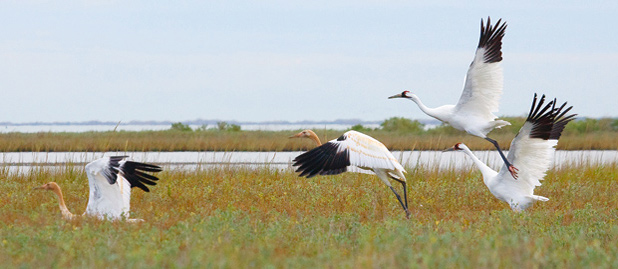|
The U.S. Endangered Species Act
Whooping Cranes by Al Perry
By the early 1900s America had witnessed the disappearance of several spectacular bird species, including the Great Auk, Passenger Pigeon, Carolina Parakeet, and Labrador Duck-lost mostly to excessive, unregulated hunting.
In 1918, as bird declines continued, the Migratory Bird Treaty Act (MBTA) was enacted to regulate "take" (including hunting and 'live' collection for the bird and egg trade). While the MBTA provided invaluable protection to birds, it only regulated hunting and capture; and did little to help species that were affected by human-induced threats such as habitat loss, introduced predators, and environmental toxins. Thus, even with the MBTA in force, birds such as the Whooping Crane and Aleutian Canada Goose continued to decline.
Bird DeclinesIn the 1950s and 60s, there was a population crash in some very visible bird species, namely the Bald Eagle, Peregrine Falcon, and Brown Pelican. Research showed that the culprits were organochlorine pesticides such as DDT, which caused eggshell thinning and dramatically reduced breeding success. As the Bald Eagle tumbled towards extinction in the lower 48 states, the impetus for greater legal protection for the country's most imperiled wildlife mounted. In 1966 the Endangered Species Preservation Act was passed. This was strengthened in 1969, and in 1973 finally became the ESA.
The scope of the ESA legislation was broad, and included a process for identifying species that qualified for listing, habitat protection measures, and a mechanism to ensure that the federal government itself did not contribute to endangered species declines. It also mandated cooperation with states, international cooperation, and trade and take restrictions. Since its passage, the Act has undergone significant amendments on three occasions, once under President Carter, and twice under President Reagan. Among the amendments made under Carter were Critical Habitat provisions, to be drawn up concurrently with species listings wherever possible; and the creation of a cabinet-level committee with the power to exempt certain federal projects from compliance with the Act (though few such exemptions have been granted). Amendments made during the Reagan presidency included: the introduction of Habitat Conservation Plans, which permitted landowners to alter habitat if they also implemented mitigation measures; a prohibition on considering the economic implications of listing a species; a requirement that "candidate" and de-listed species be monitored; a framework to improve the implementation of Recovery Plans, and the establishment of a "Cooperative Endangered Species Conservation Fund". ESA Under AttackIn 1992, authorization of the ESA expired. The prohibitions and requirements of the Act still remained in force, but appropriations had to be sought yearly. Ever since, the Act has been the focus of attacks from interest groups bent on relaxing species protections to allow increased development.
As ABC's Endangered Species Act Report illustrates, the Act continues to help endangered birds recover, and there are more than two and one-half times as many listed bird species that are increasing or stable than are decreasing. Species that are increasing have also been protected under the ESA an average of ten years longer than those that are decreasing, indicating that the longer conservation efforts continue, the better the results.
View ABC's full ESA report. |
